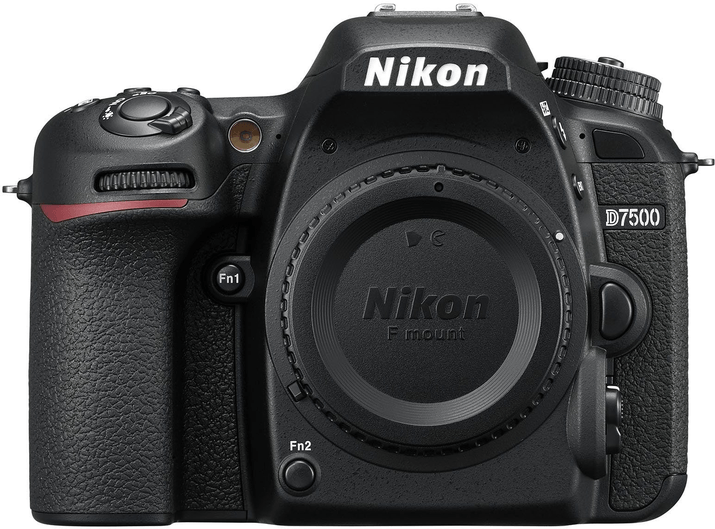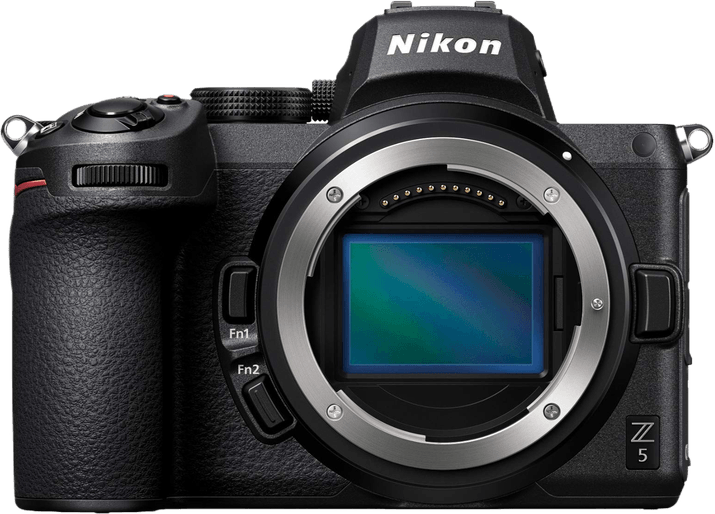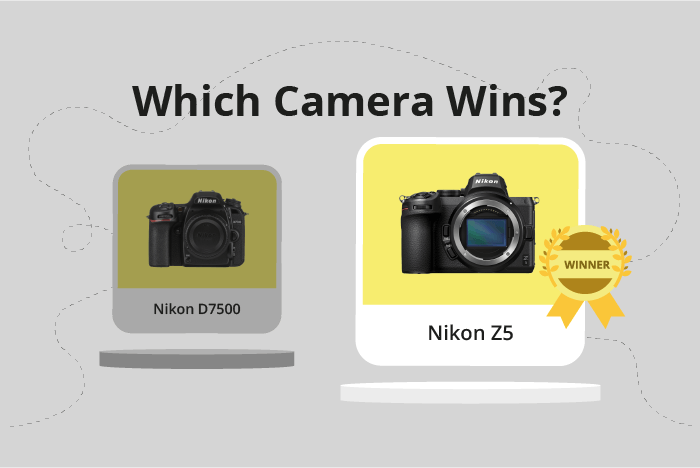Nikon D7500 vs Z5 Comparison
Nikon D7500

Nikon Z5

The Nikon Z5, with a score of 78 out of 100, outperforms the Nikon D7500, which received a score of 70. Both cameras share similarities, such as being released in the 2010s and having a similar size, with the Z5 being slightly smaller at 134 x 100.5 x 69.5mm compared to the D7500’s 136 x 104 x 73mm dimensions. However, the Z5 is a mirrorless camera, while the D7500 is a DSLR.
The Z5’s higher score is due to its advantages, such as being lighter, weighing only 675g compared to the D7500’s 720g. Although the D7500 is more affordable with a launch price of $1250 compared to the Z5’s $1400, the Z5’s improved performance and compact design make it a more attractive option for photographers.
Considering the specifications, it is clear that the Nikon Z5 is a better camera than the Nikon D7500, offering a more modern and lightweight design with superior performance.
Nikon D7500 vs Z5 Overview and Optics
The Nikon Z5 is the winner in the optics comparison with a score of 81/100, while the Nikon D7500 trails behind with a score of 68/100. Both cameras share similarities in their specifications, including a CMOS sensor and lens mount compatibility with their respective Nikon F DX and Nikon Z lenses. However, the differences in their features contribute to the contrasting scores.
The Nikon Z5 surpasses the D7500 in several aspects. It has a higher megapixel count of 24 compared to the D7500’s 20.9, which results in better image resolution. The Z5 also boasts a superior Expeed 6 processor, contributing to improved image processing. Additionally, the Z5’s full-frame sensor size and DXOMARK score of 97 outshine the D7500’s APS-C sensor size and DXOMARK score of 86, leading to enhanced image quality. Furthermore, the Nikon Z5 includes image stabilization, a feature absent in the D7500.
On the other hand, the Nikon D7500 has a faster shooting speed of 8 frames per second, doubling the Z5’s 4.5 fps. This allows the D7500 to capture fast-moving subjects more effectively. Despite this advantage, the D7500’s overall optics performance remains inferior to the Z5.
In comparing the optics of the Nikon D7500 and Z5, the Z5 emerges as the superior choice due to its higher megapixel count, advanced processor, larger sensor size, better DXOMARK score, and image stabilization. The D7500’s faster shooting speed is its only advantage, but it is not enough to outshine the Z5’s comprehensive superiority in optics performance.
Nikon D7500 vs Z5 Video Performance
The Nikon Z5 emerges as the winner in the video capabilities comparison, scoring 83 out of 100, while the Nikon D7500 scores 70. Both cameras share some common specifications, such as a maximum video resolution of 4K and dimensions of 3840 x 2160. Additionally, they both offer built-in time-lapse functionality.
The Nikon Z5 outperforms the D7500 in terms of maximum video frame rate, offering 60fps compared to the D7500’s 30fps. This higher frame rate is advantageous for capturing smoother and more detailed footage, particularly in fast-paced or action scenes. The Z5’s superior video performance makes it a more suitable option for videographers and content creators who prioritize high-quality video output.
On the other hand, the Nikon D7500’s lower video score does not necessarily mean it falls short in all aspects. The D7500 still delivers 4K video resolution, providing crisp and clear footage for casual users and those not requiring the highest frame rate. The built-in time-lapse functionality also adds versatility to the camera’s video capabilities.
Comparing the video capabilities of the Nikon D7500 and Nikon Z5 reveals that the Z5 is a better choice for those who prioritize high-quality video output and smooth frame rates. However, the D7500 remains a capable option for users with less demanding video requirements, offering 4K resolution and time-lapse features. Ultimately, the choice between these two cameras depends on individual preferences and the specific video needs of the user.
Nikon D7500 vs Z5 Features and Benefits
The Nikon D7500 emerges as the winner in the features comparison with a score of 83/100, while the Nikon Z5 scores 72/100. Both cameras share several specifications, including a 3.2-inch screen size, touchscreen capabilities, flip screens, GPS absence, Wi-Fi, and Bluetooth connectivity.
The D7500 outperforms the Z5 in terms of features. It has a higher overall score, indicating that it provides more functionality and versatility for photographers. The 11-point difference between the two cameras highlights the superiority of the D7500 in this aspect.
However, the Z5 does have an advantage in screen resolution, boasting 1,040,000 dots compared to the D7500’s 922,000 dots. This higher resolution allows for crisper and more detailed image previews on the Z5, which can be beneficial for photographers who rely heavily on their camera’s screen for composition and review.
Despite the Z5’s higher screen resolution, the D7500 remains the better camera in terms of features. Its higher score reflects its superior performance and functionality. Photographers looking for a camera with more comprehensive features should opt for the Nikon D7500.
On the other hand, if screen resolution is a critical factor, the Nikon Z5 may be a more suitable choice. However, it is essential to consider the overall feature set of each camera when making a decision. The Nikon D7500’s higher score signifies its better performance and versatility, making it the more attractive option for photographers seeking a well-rounded camera.
Nikon D7500 vs Z5 Storage and Battery
The Nikon Z5 triumphs over the Nikon D7500 in storage and battery with a score of 73/100 versus 43/100. Both cameras share compatibility with SD, SDHC, and SDXC memory cards. Additionally, they use the EN-EL battery series.
The Z5 excels with two memory card slots, allowing for more storage capacity and flexibility. It also supports UHS-II, providing faster read and write speeds. Moreover, it offers USB charging, which is convenient for on-the-go photographers.
The D7500, despite a lower score, has a significant advantage in battery life, delivering 950 shots compared to the Z5’s 470 shots. This longer-lasting battery is crucial for extended photography sessions.
Considering storage and battery aspects, the Nikon Z5 outperforms the D7500 due to its dual memory card slots, UHS-II compatibility, and USB charging. However, the D7500’s longer battery life remains an essential advantage for certain photographers.
Nikon D7500 vs Z5 – Our Verdict
Are you still undecided about which camera is right for you? Have a look at these popular comparisons that feature the Nikon D7500 or the Nikon Z5:

